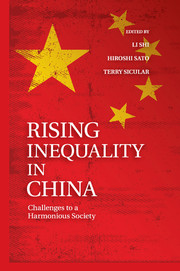Book contents
- Frontmatter
- Contents
- List of Tables
- List of Figures
- Contributors
- Preface
- Abbreviations
- Glossary
- 1 Rising Inequality in China
- 2 Overview
- 3 Housing Ownership, Incomes, and Inequality in China, 2002–2007
- 4 Educational Inequality in China
- 5 Inequality and Poverty in Rural China
- 6 The Evolution of the Migrant Labor Market in China, 2002–2007
- 7 A New Episode of Increased Urban Income Inequality in China
- 8 Unemployment and the Rising Number of Nonworkers in Urban China
- 9 Do Employees in the Public Sector Still Enjoy Earnings Advantages?
- 10 Redistributive Impacts of the Personal Income Tax in Urban China
- 11 Changes in the Gender-Wage Gap in Urban China, 1995–2007
- 12 Intertemporal Changes in Ethnic Urban Earnings Disparities in China
- Appendix I The 2007 Household Surveys
- Appendix II The 2002 and 2007 CHIP Surveys
- Index
- References
3 - Housing Ownership, Incomes, and Inequality in China, 2002–2007
Published online by Cambridge University Press: 05 July 2013
- Frontmatter
- Contents
- List of Tables
- List of Figures
- Contributors
- Preface
- Abbreviations
- Glossary
- 1 Rising Inequality in China
- 2 Overview
- 3 Housing Ownership, Incomes, and Inequality in China, 2002–2007
- 4 Educational Inequality in China
- 5 Inequality and Poverty in Rural China
- 6 The Evolution of the Migrant Labor Market in China, 2002–2007
- 7 A New Episode of Increased Urban Income Inequality in China
- 8 Unemployment and the Rising Number of Nonworkers in Urban China
- 9 Do Employees in the Public Sector Still Enjoy Earnings Advantages?
- 10 Redistributive Impacts of the Personal Income Tax in Urban China
- 11 Changes in the Gender-Wage Gap in Urban China, 1995–2007
- 12 Intertemporal Changes in Ethnic Urban Earnings Disparities in China
- Appendix I The 2007 Household Surveys
- Appendix II The 2002 and 2007 CHIP Surveys
- Index
- References
Summary
Introduction
An important feature of the post-Mao period has been the resurrection of private property rights. A variety of interrelated policies, including the lifting of prohibitions on private enterprise, ownership reforms in industry, the development of stock markets, and real estate and housing reforms, have paved the way for the expansion of private property and household wealth, with implications for incomes and inequality. Estimates by Li, Luo, and Sicular in Chapter 2 of this volume, calculated using the 2002 and 2007 China Household Income Project (CHIP) surveys, show that the share of household income derived from financial assets and housing and their contribution to income inequality has increased, especially in urban China.
In this chapter we examine changes in private ownership of housing and the implications for the distribution of housing wealth and income. We focus on housing wealth rather than on total wealth mainly because the CHIP 2007 data do not contain sufficient information to permit the estimation of total wealth. Housing wealth, however, can provide insights into the role of total wealth, because housing is the single most important household asset in China. Past studies of wealth in China have found that privately owned housing constitutes nearly 60 percent of household wealth and accounts for two-thirds of inequality in wealth among households (Li and Zhao 2008; Zhao and Ding 2008).
- Type
- Chapter
- Information
- Rising Inequality in ChinaChallenges to a Harmonious Society, pp. 85 - 141Publisher: Cambridge University PressPrint publication year: 2013
References
- 16
- Cited by



